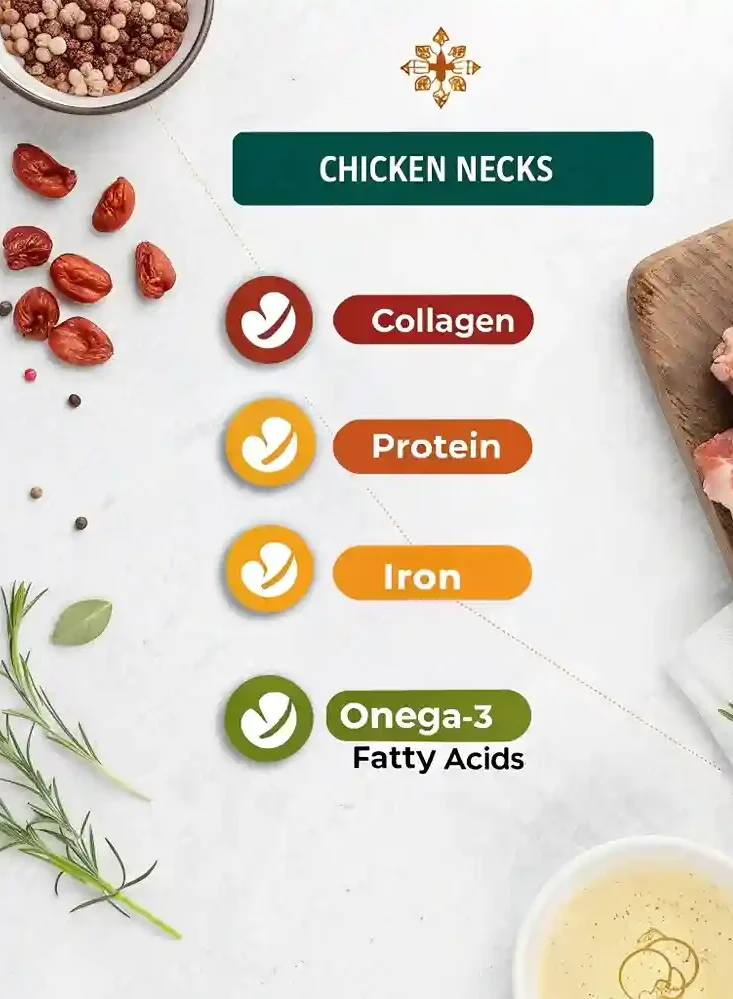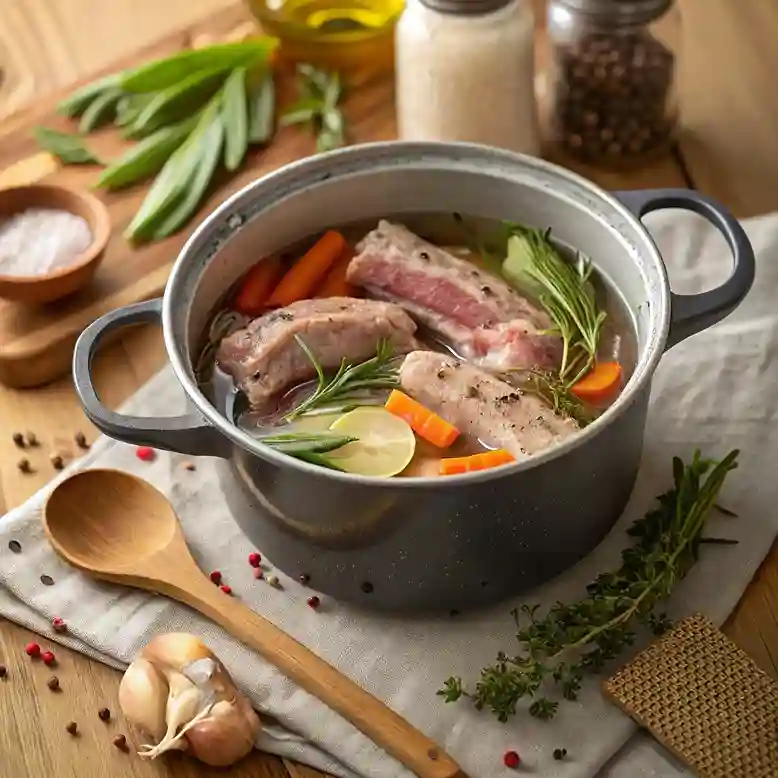What Are Chicken Necks and Their Culinary Uses?
Chicken neck nutrition is often overlooked, yet these nutrient-packed parts of the chicken are widely used in cuisines worldwide. Typically removed during the butchering process, chicken necks are discarded in many households. However, savvy cooks and health-conscious foodies are beginning to embrace them for their nutritional benefits, including high levels of collagen, protein, and essential minerals.
While the neck itself doesn’t have much muscle tissue, it is rich in cartilage, skin, and connective tissue, making it an excellent source of collagen—a vital protein that supports joint, skin, and gut health. Additionally, chicken neck nutrition includes key amino acids like glycine and proline, which aid in muscle repair and overall well-being. Chicken necks are commonly used in broths, soups, and stews, where they enhance the nutrient profile of a dish while adding a rich, savory flavor. They can also be braised, grilled, or stir-fried, making them a versatile addition to many traditional and modern recipes.

Why Should You Consider Chicken Necks for Your Nutrition?
The growing trend of utilizing every part of the animal in cooking, including chicken necks, aligns with a broader movement toward sustainable and mindful eating. In the U.S., consumers are becoming increasingly aware of the environmental impact of food waste and are seeking ways to minimize it. According to a 2021 USDA report, approximately 30-40% of food in the U.S. is wasted each year. By incorporating chicken neck nutrition into your meals, you contribute to reducing this waste while benefiting from a highly nutritious and cost-effective ingredient.
But why is chicken neck nutrition so valuable? One of its primary benefits is its high collagen content, which supports joint health, skin elasticity, and gut function. These necks are also rich in amino acids like glycine and proline, which aid in muscle recovery, tissue repair, and overall bodily function. Additionally, chicken necks provide essential minerals such as calcium (for bone strength), zinc (for immune support), and iron (for red blood cell production).
Beyond protein and minerals, chicken neck nutrition also offers healthy fats, including omega-3 fatty acids, known for reducing inflammation and supporting heart health. As more people prioritize nutrient-dense, whole foods, chicken necks are gaining recognition as a powerful addition to a health-conscious diet.
Nutritional Benefits of Chicken Necks
Chicken Necks: High in Collagen for Joint, Skin, and Gut Health
Chicken neck nutrition offers an excellent source of collagen, a vital protein that supports healthy skin, joints, and gut function. Collagen is essential for skin elasticity, helping to reduce wrinkles and improve hydration. Studies show that chicken neck nutrition enhances skin moisture, making it a natural anti-aging component.
For joint health, collagen maintains cartilage, the tissue that cushions joints. Research suggests that chicken neck nutrition may reduce joint pain and prevent cartilage deterioration. Additionally, collagen supports gut health by strengthening the intestinal lining and aiding digestion.
Scientific studies confirm these benefits. A study in Skin Pharmacology and Physiology found that women who consumed collagen for eight weeks had improved skin elasticity. Another review showed that hydrolyzed collagen could reduce joint pain and restore bone density.
Incorporating chicken neck nutrition into your diet is an effective way to boost collagen intake, promoting overall well-being.
Protein-Packed Chicken Necks: A Great Source of Amino Acids
Chicken necks are a powerhouse of protein, making them an excellent choice for those looking to support muscle growth, tissue repair, and overall health. With approximately 18-20 grams of protein per 100 grams, they provide a rich source of essential and non-essential amino acids necessary for bodily functions.
Key Amino Acids in Chicken Necks and Their Benefits
- Glycine – Plays a crucial role in collagen production, supporting skin, joint, and gut health. It also enhances cognitive function and improves sleep quality.
- Proline – Essential for cartilage health and wound healing, proline helps maintain skin elasticity and supports joint flexibility.
- Arginine – Known for its role in boosting immune function, promoting heart health, and improving blood circulation by aiding nitric oxide production.
Protein from animal sources like chicken necks is highly bioavailable, meaning the body can efficiently absorb and utilize it. This makes them an excellent option for athletes, individuals recovering from injuries, and those following high-protein diets.
Why Protein from Chicken Necks Matters
- Supports muscle repair and growth, making it a great option for fitness enthusiasts.
- Aids in metabolism regulation, helping with weight management.
- Contributes to immune system strength by providing building blocks for antibodies.
By incorporating chicken necks into meals, you can naturally boost your protein intake while also benefiting from their unique nutrient profile.
Mineral-Rich: Calcium, Zinc, and Iron
Chicken necks are not only rich in protein and collagen, but they also provide essential minerals that contribute to overall health. These include calcium, zinc, and iron, all of which play crucial roles in the body’s daily functions. Including chicken necks in a well-balanced diet can help meet your mineral requirements naturally.
Key Minerals Found in Chicken Necks and Their Benefits
- Calcium – Essential for Strong Bones and Teeth
- Calcium is crucial for bone density and strength, helping to prevent conditions like osteoporosis.
- It also supports muscle function and nerve signaling, making it an essential mineral for overall mobility.
- Chicken necks, particularly when slow-cooked or used in bone broth, release bioavailable calcium that is easily absorbed by the body.
- Zinc – Boosts Immunity and Supports Metabolism
- Zinc is vital for a strong immune system, helping the body fight infections.
- It plays a role in wound healing, skin regeneration, and hormonal balance.
- A diet rich in zinc supports enzymatic functions and metabolism, making it a key nutrient for energy production.
- Iron – Improves Blood Health and Oxygen Circulation
- Iron plays a crucial role in the formation of red blood cells and helps transport oxygen efficiently throughout the body.
- A deficiency in iron can lead to fatigue, dizziness, and anemia, which is common in individuals with low iron intake.
- Chicken necks provide a bioavailable source of heme iron, which is more easily absorbed than non-heme iron from plant sources.

How These Minerals Complement a Balanced Diet
Incorporating chicken necks into your meals can provide these vital minerals in a natural and highly absorbable form. Slow-cooking or simmering them in broths and stews enhances their nutrient release, making them an excellent addition to a nutrient-dense diet.
By consuming chicken necks as part of a diverse, whole-food-based diet, you can support bone health, immune function, and blood circulation, all while enjoying their rich flavor and versatility.
Fat Content and Omega-3 Fatty Acids
Chicken necks contain a moderate amount of fat, providing both essential fatty acids and energy for the body. While some people may associate chicken fat with unhealthy saturated fats, it’s important to note that chicken necks also contain beneficial unsaturated fats, including omega-3 fatty acids, which play a key role in heart health and inflammation reduction.
Fat Profile of Chicken Necks
- Saturated Fats (Moderate Amount) – While excessive intake of saturated fats can contribute to heart disease, small amounts are necessary for hormone production and cellular function.
- Monounsaturated Fats – These heart-healthy fats help reduce bad cholesterol (LDL) levels and support brain function.
- Polyunsaturated Fats (PUFAs) – These include omega-3 and omega-6 fatty acids, which are essential for inflammation control and cardiovascular health.
Omega-3 Fatty Acids and Their Health Benefits
The omega-3 fatty acids in free-range chicken necks can support heart health and reduce inflammation (CDC). For those managing diabetes, including lean protein sources in their diet can help stabilize blood sugar levels (NIDDK).
How to Cook Chicken Necks for Maximum Nutrition
Making Bone Broth with Chicken Necks: A Collagen-Rich Tonic
Chicken necks are an excellent base for bone broth, which is packed with collagen, essential minerals, and gut-supporting nutrients. Slow-cooking the necks helps extract these benefits, making the broth a highly nutritious addition to any diet. According to Harvard T.H. Chan School of Public Health, collagen from bone broth plays a key role in maintaining joint health and supporting digestion.
Why Bone Broth is a Nutritional Powerhouse
- Collagen & Gelatin – Essential for joint support, skin elasticity, and gut lining repair.
- Calcium, Magnesium & Phosphorus – Strengthen bones, teeth, and muscle function.
- Amino Acids (Glycine & Proline) – Aid digestion, sleep quality, and inflammation reduction.
How to Make a Nutrition Chicken Neck Bone Broth

Bone Broth with Chicken Necks
Ingredients
- Ingredients:
- 2 lbs chicken necks organic/free-range preferred for higher nutrient quality
- 8 cups filtered water
- 2 tbsp apple cider vinegar helps extract minerals from the bones
- 1 onion chopped
- 2 carrots chopped
- 2 celery stalks chopped
- 3 cloves garlic smashed
- 1 tsp sea salt adjust to taste
- 1 tsp whole black peppercorns
- 1-2 bay leaves
- Optional herbs: Thyme rosemary, parsley
Instructions
- Cooking Instructions:
- Prepare the Chicken Necks:
- Rinse the chicken necks under cold water and pat them dry.
- For a deeper, richer flavor, roast them at 375°F (190°C) for 20 minutes before simmering.
- Combine Ingredients:
- In a large pot or slow cooker, add chicken necks, vegetables, and seasonings.
- Pour in water and add apple cider vinegar to help release nutrients.
- Simmer Slowly:
- On Stovetop: Bring to a gentle boil, then reduce heat to low and simmer for 12-24 hours.
- In Slow Cooker: Set on low for 24 hours.
- In Instant Pot: Use pressure cook mode for 2-3 hours.
- Strain & Store: Remove solids using a fine mesh strainer.Let the broth cool, then store in glass jars in the fridge for up to 5 days or freeze for up to 3 months.
Notes
Tips to Enhance Your Bone Broth
- Boost Flavor & Nutrition: Add turmeric, ginger, or lemongrass for anti-inflammatory benefits.
- Increase Collagen Extraction: Break the bones slightly before cooking.
- For a Gelatinous Texture: Ensure a long, slow simmer to extract more gelatin.
- Use for Multiple Recipes: Drink it warm, use as a base for soups and stews, or blend into sauces.
Final Thoughts “chicken neck nutrition”
Chicken neck nutrition shines in bone broth, offering an easy, cost-effective, and nutritious way to add collagen, minerals, and amino acids to your diet. Chicken neck nutrition supports digestion, skin health, and joint function, making this broth a powerhouse for overall well-being.
Drink it daily as a gut-healing tonic or use it in cooking. It’s far better than store-bought broth with preservatives. Incorporating chicken neck nutrition into homemade bone broth enhances flavor and maximizes nutritional benefits.
Grilled or Braised Chicken Necks: A Flavorful, Nutrient-Dense Dish
Chicken neck nutrition makes grilled or braised chicken necks a flavorful, tender, and nutrient-dense dish when cooked properly. High in collagen, protein, and minerals, these cuts transform beautifully with slow cooking or grilling, ensuring rich taste and melt-in-your-mouth texture.
Using the right cooking method enhances chicken neck nutrition, making them a great addition to any balanced diet. Try marinating before grilling or slow-braising for maximum flavor and nutritional benefits.
Why Choose Grilled or Braised Chicken Necks?
- High in Collagen & Protein – Supports skin, joints, and muscle recovery.
- Budget-Friendly & Sustainable – A great way to use every part of the chicken.
- Deep, Rich Flavor – Perfect for slow-cooked comfort dishes or smoky grilled meals.
1. Grilled Chicken Necks Recipe
Grilling locks in flavor while giving the chicken necks a deliciously crispy, slightly charred texture.

Ingredients:
- 2 lbs chicken necks (organic/free-range preferred)
- 2 tbsp olive oil
- 1 tbsp lemon juice
- 2 cloves garlic, minced
- 1 tsp smoked paprika
- ½ tsp black pepper
- ½ tsp sea salt
- ½ tsp cayenne pepper (optional, for heat)
- Fresh herbs (rosemary, thyme, or oregano) for garnish
Instructions:
- Marinate the Chicken Necks:
- In a bowl, mix olive oil, lemon juice, garlic, and spices.
- Coat chicken necks evenly and marinate for at least 1 hour (or overnight for deeper flavor).
- Grill to Perfection:
- Preheat the grill to medium-high heat (375-400°F / 190-200°C).
- Grill chicken necks for 10-12 minutes, turning occasionally, until crispy and golden brown.
- Check that the internal temperature reaches 165°F (75°C).
- Serve & Enjoy:
- Garnish with fresh herbs and serve with a side of roasted vegetables or a fresh salad.
2. Braised Chicken Necks Recipe
Braising slowly cooks the chicken necks in a flavorful liquid, making them fall-off-the-bone tender while preserving all their nutrients.

Ingredients:
- 2 lbs chicken necks
- 1 tbsp olive oil
- 1 onion, finely chopped
- 2 carrots, sliced
- 2 garlic cloves, minced
- 1 tsp tomato paste
- ½ tsp cumin
- ½ tsp turmeric
- ½ tsp black pepper
- 1 tsp sea salt
- 2 cups chicken broth or bone broth
- 1 bay leaf
- Fresh parsley for garnish
Instructions:
- Sear the Chicken Necks:
- Heat olive oil in a large pan over medium-high heat.
- Sauté the chicken necks for about 5 minutes, flipping them occasionally, until they achieve a rich golden-brown color.
- Build the Flavor:
- Add onion, carrots, and garlic, sauté until softened.
- Mix in the tomato paste, along with cumin, turmeric, salt, and pepper.
- Braise Slowly:
- Pour in chicken broth, add bay leaf, and bring to a gentle simmer.
- Cover and cook on low heat for 1.5 – 2 hours, until tender and flavorful.
- Serve & Enjoy:
- Garnish with fresh parsley and serve with steamed rice, quinoa, or mashed potatoes.
Final Thoughts
Grilled or braised, chicken necks are a delicious, protein-packed, and budget-friendly way to incorporate more nutrient-dense meals into your diet. Whether you prefer the smoky charred taste of grilling or the comforting richness of braising, these methods unlock the full potential of this underrated cut!
For more recipe ideas, check out our 5 Delicious Chicken Neck Recipes You Need to Try Today and explore creative ways to make delicious, eye-catching dishes!
Potential Risks of Cooking with Chicken Necks
Be Aware of Small Bones
Chicken necks contain numerous small, delicate bones that can pose a choking hazard or cause digestive issues if not handled properly. These bones are softer than weight-bearing bones, but they still require careful preparation to ensure safe consumption.
Tips for Safe Cooking and Eating:
- Slow Cooking for Softening Bones – Simmering chicken necks in soups or bone broth for several hours can break down the bones, making them safer to consume.
- Straining the Broth – If making bone broth, use a fine-mesh strainer to remove any bone fragments before serving.
- Deboning Before Serving – For grilled or braised chicken necks, carefully remove small bones before eating, especially when serving children or elderly individuals.
- Chew Carefully – If consuming whole chicken necks, eat slowly and be mindful of bones.
By following these precautions, you can enjoy the nutritional benefits of chicken necks while minimizing any potential risks.
Fat Content Considerations
Chicken necks contain a moderate amount of fat, including both saturated and unsaturated fats. While fat is an essential macronutrient that provides energy and supports various bodily functions, individuals on low-fat diets or those managing conditions like heart disease may need to be mindful of their intake.
Managing Fat Intake When Cooking Chicken Necks:
- Skimming Excess Fat – When making bone broth or soups, allow the liquid to cool and remove the top layer of fat before reheating and serving.
- Grilling Instead of Frying – Grilling helps render excess fat while preserving flavor, making it a healthier alternative to deep-frying.
- Using Lean Cooking Methods – Braising or slow-cooking with minimal added fats can help control overall fat content while still making the meat tender and flavorful.
- Pairing with Fiber-Rich Ingredients – Combining chicken necks with vegetables like kale, carrots, or beans can help balance fat intake and support digestion.
By adopting these healthy cooking techniques, you can enjoy the nutritional benefits of chicken necks while maintaining a well-balanced diet.
Reducing Food Waste
The growing focus on sustainability and reducing food waste is reshaping how we approach cooking, and using every part of the animal—such as chicken necks—plays a key role in this movement. In the past, cuts like chicken necks were often discarded or overlooked, but as more consumers seek ways to minimize waste, chicken necks are becoming a prized, cost-effective ingredient.
Chicken Necks in the Context of Sustainability and Cost-Effective Cooking:
- Utilizing All Parts of the Animal – Using chicken necks, along with other traditionally discarded parts like wings, feet, and organs, promotes the philosophy of nose-to-tail cooking. This not only helps reduce waste but also makes the cooking process more sustainable by maximizing the value of every animal used.
- Bone Broths and Stocks – Chicken necks, when simmered, release rich nutrients, including collagen, minerals, and protein. This process allows you to create flavorful broths while reducing food waste. Experts in the culinary industry recommend this method as a way to extract maximum value from affordable, overlooked cuts of meat.
- Sustainability Impact – According to the U.S. Department of Agriculture (USDA), food waste accounts for a significant portion of environmental issues, such as greenhouse gas emissions. By using chicken necks, individuals are helping reduce the environmental impact associated with food waste and promoting more eco-friendly cooking practices.
Cost-Effective Cooking for Families:
Chicken necks are an incredibly affordable protein source—often priced much lower than more popular cuts like chicken breasts or thighs. This makes them an excellent choice for budget-conscious families looking to maintain a nutritious diet without breaking the bank. By incorporating chicken necks into recipes like bone broths, stews, and braised dishes, families can create hearty, nutrient-dense meals without overspending on expensive proteins.
This trend of cost-effective cooking also ties in with the larger movement toward meal prepping and batch cooking, which helps reduce food waste while saving money in the long term. Consumers are more likely to appreciate the value of sustainably sourced, low-cost protein as they become increasingly aware of its benefits to both their wallet and the planet.
The Bigger Picture:
Using chicken necks is part of a larger societal shift towards conscious consumption—eating in a way that promotes health, reduces waste, and supports sustainable farming practices. By embracing affordable cuts like chicken necks, individuals can contribute to this change, reducing their environmental footprint while benefiting from a nutritious and versatile ingredient.
In summary, the movement towards using all parts of the animal, including chicken necks, helps reduce food waste, supports sustainable cooking, and provides an affordable source of protein for families. Embracing these changes in our everyday cooking habits can help create a more sustainable food system while also benefiting our health and budget.
Increasing Popularity in Sustainable Recipes
The trend of nose-to-tail eating, which advocates using every part of the animal, has gained significant traction in the U.S., with a growing number of chefs, home cooks, and sustainable food advocates embracing this approach. This trend, originally popularized by high-end restaurants focused on reducing food waste and promoting ethical sourcing, has now expanded into mainstream cooking, as consumers seek to make more sustainable choices in their kitchens.
Where to Buy Chicken Necks and How to Choose Quality
Finding Chicken Necks at Local Butcher Shops and Farmers’ Markets
If you’re looking to buy chicken necks for their nutritional benefits and culinary versatility, there are several places to explore in your local area and online. Here’s where to find high-quality chicken necks and tips for selecting the best options:
1. Local Butcher Shops and Meat Markets:
Local butcher shops are an excellent place to find fresh chicken necks. Specializing in whole animal butchery or nose-to-tail cooking, many butchers offer cuts not typically available in supermarkets. Establishing a relationship with your butcher can allow you to request cuts like chicken necks, which might not always be in display but can be ordered ahead.
These shops often source meat from local farms or ethical suppliers, ensuring fresh and high-quality products. Chicken necks from such sources are likely to come from well-raised animals. Some butchers might even provide expert cooking advice, guiding you on how to prepare these nutrient-packed cuts.
2. Farmers’ Markets:
Farmers’ markets are another excellent source for sustainably raised meats, including chicken necks. Many small-scale, independent farmers who practice ethical farming and free-range poultry farming sell their products at these markets. Chicken necks from these sources are likely to be fresher and more nutrient-dense compared to mass-produced options found in larger grocery stores.
At farmers’ markets, look for vendors who specialize in pastured poultry or whole animal butchery, as these farmers typically sell a variety of cuts, including chicken necks. You can also inquire about how the chickens are raised and ask for recommendations on cooking methods that retain the nutritional benefits of the necks.
3. Online Retailers and Specialty Stores:
For those who cannot find chicken necks locally, online retailers can be a convenient option. Websites such as U.S. Wellness Meats, Crowd Cow, or Vital Choice offer a wide range of sustainable meats, including chicken necks. These online platforms provide high-quality cuts sourced from ethical and sustainable farms, making it easy to find fresh chicken necks delivered to your doorstep.
When purchasing chicken necks online, be sure to check for certifications such as organic, free-range, or pastured to ensure that you’re getting a product that’s raised in a healthy and sustainable manner.
4. Supermarkets and Large Grocery Chains:
Some large grocery chains may carry chicken necks, often in their ethnic food sections or international markets. These cuts are popular in Asian, Caribbean, and Latin American cuisines, so checking those areas in your supermarket can help. Many halal markets and international food stores also stock chicken necks for traditional recipes.
Choosing High-Quality Chicken Necks: Organic, Free-Range, and More
When selecting chicken necks, whether at a butcher shop, farmers’ market, or online, consider the following tips to ensure you’re getting the freshest, highest-quality product:
- Look for Firmness: Fresh chicken necks should feel firm and moist, not slimy or overly soft.
- Check the Color: The necks should be a pale pink or light yellowish color. Avoid necks that appear gray or discolored, as this could indicate aging or improper storage.
- Smell for Freshness: The necks should have a clean, neutral smell. A strong or sour odor could be a sign of spoilage.
- Check for Proper Storage: Make sure the chicken necks are kept on ice or in refrigerated displays, especially in butcher shops or farmers’ markets. If buying online, ensure the product is shipped with refrigerated packaging or cold packs to maintain freshness.
By buying chicken necks from trusted sources, you’re not only ensuring quality and flavor but also supporting sustainable agriculture and ethical meat practices. Whether you’re cooking for health benefits, sustainability, or just to try something new, chicken necks offer a nutritious and affordable option.
Choosing High-Quality Chicken Necks
When selecting chicken necks for cooking, focusing on the quality of the product is crucial to ensure optimal nutritional value and flavor. Here’s how to choose the best chicken necks for your recipes:

1. Organic and Free-Range Options:
Choosing organic or free-range chicken necks ensures higher nutritional value. These chickens are raised without synthetic hormones or antibiotics and have space to roam freely. As a result, their meat has a better fat profile and higher omega-3 fatty acids, which help reduce inflammation and support overall health.
Research indicates that pastured and organic poultry contains more vitamins and minerals, a better fat-to-protein ratio, and fewer contaminants like pesticides or growth hormones. Free-range farming allows chickens to develop naturally, leading to superior meat quality compared to conventionally raised poultry (Source: American Grassfed Association).
2. Ethical and Sustainable Sourcing:
Choosing ethically raised and sustainably sourced chicken necks is important. Look for certifications like Certified Humane, Animal Welfare Approved, or Global Animal Partnership. These labels ensure humane farming practices and better meat quality. Chickens raised in these conditions often have higher collagen and a more balanced omega-3 profile than conventionally farmed poultry.
Ethical sourcing improves both flavor and nutrition while supporting sustainable eating trends. More consumers now consider the environmental impact of food choices. Choosing sustainable meat helps reduce food waste and promote responsible farming.
3. Freshness and Storage:
When buying chicken necks, the freshness of the product is key to achieving optimal flavor and nutrition. Fresh chicken necks should be firm, moist, and have a clean smell. If purchasing from a butcher or farmers’ market, ask about the harvest date to ensure you’re getting the freshest product. Frozen chicken necks are also a good option, as long as they have been frozen properly and stored at the correct temperature to prevent spoilage.
It’s also essential to store chicken necks properly once purchased. If they aren’t being cooked immediately, store them in the coldest part of your fridge or in the freezer to maintain freshness and preserve nutritional value.
4. Look for Signs of High-Quality Meat:
High-quality chicken necks will often have a clean, pale color, with a slight pinkish hue. This indicates that the meat is fresh. On the other hand, if the chicken necks appear gray or discolored, it could be a sign of aging or improper storage, which can negatively affect both the flavor and nutritional quality.
By choosing organic, ethically sourced chicken necks, you not only enjoy a more nutritious and flavorful meal but also contribute to sustainable farming practices that prioritize animal welfare and environmental responsibility.
Embrace Chicken Necks for Better Nutrition
Final Thoughts on the Nutritional Power of Chicken Necks
Chicken neck nutrition is often overlooked, yet these cuts are a powerhouse of essential nutrients that support overall health. They provide a unique combination of collagen, protein, and minerals, benefiting skin, joints, and digestion. Additionally, their omega-3 fatty acids contribute to heart health and help reduce inflammation, making them an excellent choice for health-conscious individuals.
By experimenting with different cooking methods—such as bone broth, grilling, or braising—you can enjoy both the rich flavors and the nutritional benefits of chicken neck nutrition. These cuts offer a sustainable and cost-effective solution for those looking to minimize food waste while embracing nose-to-tail eating.
Now it’s your turn! Have you tried cooking with chicken necks? Share your chicken neck nutrition recipes and tips in the comments below. If you found this post helpful, share it on social media to spread the word about this nutritious and affordable ingredient!
If you love exploring unique recipes, why not try your hand at baking too? Check out my Easy Unicorn Cake Recipe and Unicorn Cake Design to add some creativity to your kitchen!


2 thoughts on “Chicken Necks for Nutrition”